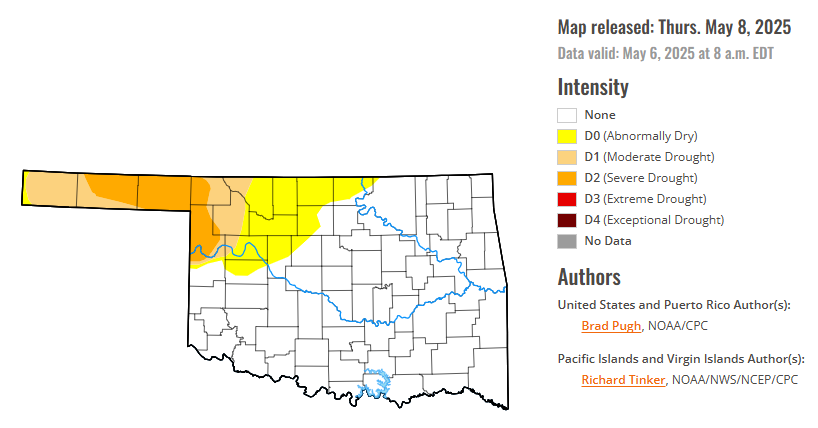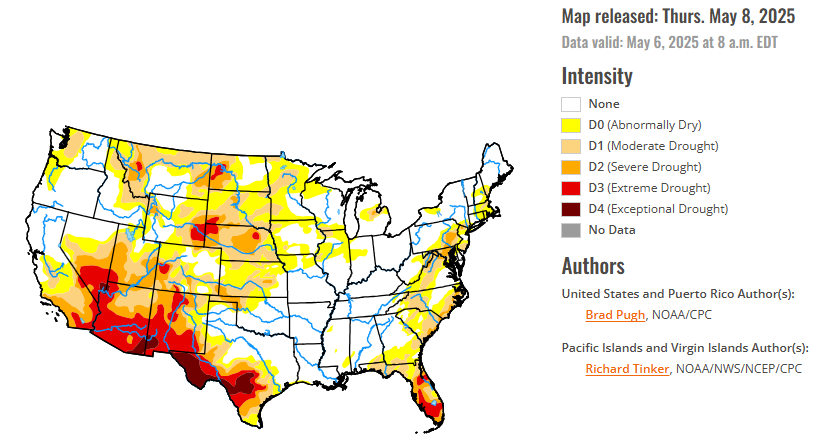
To view the latest Oklahoma drought map, CLICK HERE.
According to the latest Oklahoma drought monitor report, exceptional drought remains at zero percent, unchanged from the start of the calendar year.
Extreme drought or worse conditions remain at zero percent, unchanged since the week of October 29, 2024.
Severe drought or worse conditions are unchanged at 6.91 percent from last week.
Moderate drought or worse conditions have decreased to 13.95 percent, down from 14.14 percent last week.
Abnormally dry or worse conditions have decreased to 24.91 percent, down from 33.14 percent last week.
According to the 6-to-10-day precipitation outlook map, the Southwestern part of the state of Oklahoma, along with the panhandle, the Southeastern corner, and a thin band along the Red River, is near normal chances of precipitation through May 17. The Northwest, Central, South Central, Northeastern and Eastern portions of the state are leaning above a 33-40% chance of precipitation through May 17. A pocket in Northern Oklahoma is leaning above a 40-50% chance of precipitation through that May 17th date.

To view the United States Drought Map, CLICK HERE.
A blocking weather pattern that is common during the spring resulted in a couple of slow-moving low-pressure systems from the end of April through the start of May. These low-pressure systems brought heavy precipitation (more than 2 inches) and drought improvement to the Northeast, Mid-Atlantic, and Southern Great Plains. The heavy precipitation across Oklahoma, western Texas, and eastern New Mexico was accompanied by cooler-than-normal temperatures. Further to the north, drought expanded and intensified across portions of the Central to Northern Great Plains. Another area that experienced worsening drought was the Florida Peninsula. For the West, drought improvements were made to parts of Arizona, Utah, and western Montana. No changes were made this week to Hawaii, while Alaska and Puerto Rico remain drought-free.
In the Southern Plains, heavy precipitation (more than 2 inches) resulted in improvements to parts of Oklahoma and Texas. According to the Oklahoma Mesonet, 10 to 16 inches of precipitation were observed across central to southwestern Oklahoma during the past 30 days. A 2-category improvement was warranted to the north of Midland based on a favorable response among soil moisture indicators. Any precipitation that occurred after 8 am EDT on Tuesday, May 9th, will be considered in the next U.S. Drought Monitor release. A very tight gradient from excessive wetness across much of Oklahoma to extreme and exceptional drought closer to the Upper and Middle Rio Grande Valley has become established this spring. Minor improvements were made to the small abnormal dryness areas depicted in parts of Mississippi and eastern Tennessee.
In the High Plains, mostly dry weather prevailed this past week (April 29 to May 5) across the Northern to Central Great Plains. Based on multiple soil moisture indicators, including CPC, NLDAS, and NASA SPoRT, along with the Vegetation Drought Response Index (VegDri), extreme drought (D3) was expanded to include more of western North Dakota. This D3 expansion coincides with recent wildfires and dust storms. Soil moisture (below the 10th percentile), VegDri, and 60 to 90-day SPEI supported an expansion of severe drought (D2) across central Nebraska. D3 was added to parts of northeastern Nebraska based on VegDRI soil moisture below the 5th percentile and a longer-term extreme drought signal. Further to the west, a broad 1-category improvement was made to northeastern Wyoming and adjacent areas of western South Dakota due to recent wetness and a positive recovery among multiple drought indicators. Improvements were also warranted for the upper Green River basin of western Wyoming. However, a drier-than-normal April resulted in a 1-category degradation to parts of southern Wyoming.
In the West, recent widespread, heavy precipitation, along with consideration of multiple drought indicators such as SPI at various time scales, soil moisture, 28-day average streamflows, and the NDMC drought blends, led to a 1-category improvement across eastern New Mexico. Improvements were also warranted for parts of Arizona due to April precipitation averaging at or above normal. Minor improvements were justified for parts of western and southeastern Montana, but abnormal dryness (D0) and moderate drought (D1) expanded across parts of north-central Montana that missed out on another week of spring precipitation. No changes were made this week to California or Nevada as those areas enter a drier time of year. For the Pacific Northwest, long-term drought is limited to the northern Cascades region of Washington.
Looking ahead, a cut-off low-pressure system is forecast to bring widespread, heavy precipitation to the Southeast with the Weather Prediction Center depicting more than 3 inches of precipitation for southeastern Alabama, central to south Georgia, and the Florida Panhandle through May 12. Following a wet week, another round of precipitation (1 to 2 inches) is expected from northern New Jersey northward to New England on May 9 and 10. Elsewhere, mostly dry weather is forecast for the Corn Belt along with much of the Great Plains and the West. The dry weather will be accompanied by unseasonably warm temperatures across the Northern Great Plains. By May 12, precipitation is forecast to overspread the Pacific Northwest as a low-pressure system tracks inland from the northeastern Pacific.
The Climate Prediction Center’s 6-10 day outlook (valid May 13-17, 2025) favors above-normal precipitation for the Mid-Atlantic, Florida Peninsula, Upper Mississippi Valley, Northern to Central Great Plains, and much of the West. Elevated below-normal precipitation probabilities are limited to the Lower Mississippi Valley, western Gulf Coast, and Rio Grande Valley. Above-normal temperatures are likely for most of the eastern and central U.S., with the largest probabilities (more than 80 percent) forecast for the Great Lakes. Below-normal temperatures are favored throughout the West.
To view the 6-10 Day Precipitation Outlook Map, click here.
To view the 6-10 Day Temperature Outlook Map, click here.
To view the Monthly Drought Outlook Map, click here.

















